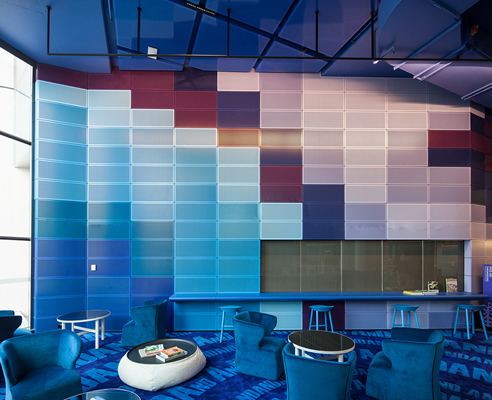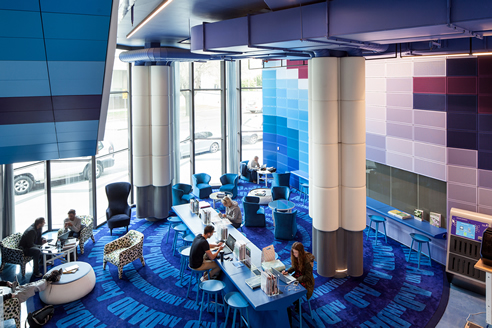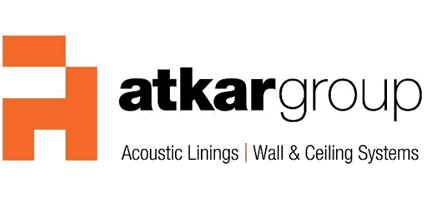The Geelong Library and Heritage Centre is a unique, multiple award-winning domed building designed by ARM
Architecture. Based on some of the great domed reading rooms of the past, it reimagines what a library can be in the
21st century.
"The librarians' brief was for a contemporary people environment. That means moving away from the traditional
model of a library as a quiet and meditative study environment to one that celebrates community interactions and
exchange," says Andrea Wilson, Principal at ARM Architecture.
The aim to cater for a range of different community outcomes - including activities noisier than traditionally
associated with libraries - creates the need for best-practice acoustic management. ARM Architecture worked closely
with Atkar, an Australian-owned company renowned for its architectural solutions and bespoke acoustic panelling.
"Atkar collaborated with ARM and Kane Constructions to prototype and manufacture a range of highly effective panels
that could fit the sometimes unusual contours of the interior spaces across the library and heritage centre's five
levels," Atkar Director Phil Grimshaw says.

Grimshaw says the project demonstrates what is possible in acoustic design for public building design: "As an award-winning
public space, it generates awareness around the vital role well-designed acoustics play in creating a great
atmosphere and a place that people want to come back to again and again."
The library combines open-plan community activity areas, more contemplative spaces, plus meeting rooms and
lecture theatres. The ground floor is the centre of this new, community-oriented redefinition of what a library can be.
Entirely open, it includes a café and nooks to read newspapers and magazines.
"It's got spaces to gather informally and chat, and it has a mezzanine that overlooks the entire space through windows
to the most wonderful garden settings beyond. There is also encouragement for people to meander out onto open-air
patios overlooking the garden," Wilson says.
With these lively purposes built into the architecture, it was imperative that the best possible acoustic dampening was
integrated into the design. ARM considered this from several angles, combining noise-absorbent furnishings such as a
large and vibrant circular carpet with prominent padded columns throughout the split-level ground floor and
mezzanine space.
But, with the ground floor open to the patios and park, the use of a concrete floor meant that Atkar's custom-made
panels on the ceiling and walls were the fitting solution to effectively minimise noise reflected from hard surfaces.
"The acoustic panelling on the ceiling and walls plays a huge role in reducing reflectivity," says founding director and
ARM partner Ian McDougall.
"Atkar - who we've worked with before and who specialise in this particular sort of finish - do a great job. It's a high-quality
finish as well as being extremely effective in the way that it works from an acoustic point of view," he says.
In its application to contemporary construction, acoustics is, in part, a science of minimising reverberation times,
which are measured in seconds against the time it takes for sound to decay by 60 decibels. The higher the
reverberation time the more acoustically 'live' a space is, whereas a low time indicates a less reverberant or
acoustically 'dead' space.
In its recently revised guidelines for sound levels and reverberation times for building interiors, Standards Australia
recommends that reading areas in libraries aim for noise levels of between 40 and 45 decibels, with reverberation
times of 0.4 to 0.6 seconds.
Atkar regularly subjects it products to independent acoustic testing and the results of these tests are studied by
engineers and scientists such as those at Vipac, the firm ARM used to advise on acoustic implementation for the
Geelong project.
"From a technical perspective, Vipac was engaged to ensure that echoing didn't occur and that noise transfer from the
hard floor, and from one level to the next, also didn't occur. That requires a level of technical expertise and that's why
we employ acoustic engineers," Wilson says.
Geelong has taken to its new community-oriented library with gusto. In the 11 months since it has opened, the new
building has welcomed over 454,000 visitors. Average monthly visits are now around 38,500, compared with 14,000 to
the old Geelong Library. Membership rates have also seen a significant increase, indicating people are planning to
make the library an ongoing part of their lives.
And while Geelong residents are thrilled to have a distinctive reimagining of the library for the 21st century - a place
where no one is going to get 'shushed' and community interaction is celebrated - Atkar is quietly working away in the
background, providing state-of-the-art bespoke solutions that keep noise to a minimum.







 Antimicrobial Technology for Wall and
Antimicrobial Technology for Wall and How to Save Time and Money on Commercial
How to Save Time and Money on Commercial Acoustic Control Fabric Finish Project
Acoustic Control Fabric Finish Project Decorative acoustic panels for Aged Care
Decorative acoustic panels for Aged Care Modern Plasterboard Ceilings - Vogl from
Modern Plasterboard Ceilings - Vogl from Antimicrobial Timber Coatings with
Antimicrobial Timber Coatings with Continuous Linear Ceiling Feature Panels
Continuous Linear Ceiling Feature Panels Au.diSlat Linear Timber Slat Modules by
Au.diSlat Linear Timber Slat Modules by Low Cost Acoustic Panels Ready in 10
Low Cost Acoustic Panels Ready in 10 Acoustic Panels Custom Manufacture &
Acoustic Panels Custom Manufacture & Continuous Interior Timber Panel Systems
Continuous Interior Timber Panel Systems Custom Premium Acoustic Lining System
Custom Premium Acoustic Lining System Unique Seamless Plasterboard Acoustic
Unique Seamless Plasterboard Acoustic Perforated Acoustic Plaster Ceilings -
Perforated Acoustic Plaster Ceilings - Wet Area Internal Lining Design & Supply
Wet Area Internal Lining Design & Supply Durable Fibre Cement Interior Lining
Durable Fibre Cement Interior Lining Wall or Ceiling Lining Fire Group
Wall or Ceiling Lining Fire Group Premium Timber Veneer Selection with
Premium Timber Veneer Selection with 3D Acoustic Panel Online Visualiser by
3D Acoustic Panel Online Visualiser by Acoustic Ceiling Design for Wet Areas
Acoustic Ceiling Design for Wet Areas
